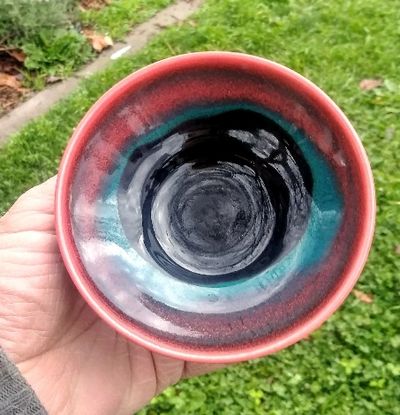- Home
- Market Schedule
- New work 6/26/24
- New work for Ikebana 6/24
- Work in progress 04/27/24
- Work in progress 03/11/24
- Work in progress 10/30/23
- Work in progress 9/1/23
- Work in progress 7/10/23
- Work inprogress 5/15/2023
- Work in progress 4/3/2023
- San Francisco visit 11/22
- Santa Clara/Oakland 10/29
- Rebuild Update10, 8/13/22
- Wildfire Aftermath 09/21
- New work 6/2021
- My Online Store
- New work 1/21
- New Work 10/30/20
- New Work 9/18/20
- New Work 7/16/20
- Pearls
- Pottery making videos
- Pollock Pines Fall Color
What clay is
As the Earth was cooling from a molten ball of magma, the heavier metallic elements were pulled to the center under gravity, where much remains molten today. The lighter silicates floated to the surface, and cooled to form the earth's crust. The crust's most common mineral is feldspar ("Field stone").

As feldspar decomposes over the millennia under the attack of water and ice, it is finally broken down into kaolin. A kaolin crystal is very tiny, only visible under an electron microscope. I include a few electron micrographs here in my slideshow. These flat crystals attract water to their surfaces. They therefore cling, and slide across one another, forming a malleable mass which can be squeezed and shaped.

"Birth of clay" slideshow
Kaolin tends to form at higher elevations in the presence of freezing temperatures. It collects in pockets, which themselves are eroded, and washed downstream where the kaolin can settle in a still pool or lake bed. Eventually, the lake may be filled up, and buried under grasslands and forests. Another river may cut through such a kaolin deposit, and wash it far downstream. This churning and tumbling fractures the crystals into ever finer particles. Eventually, these crystals may be deposited in another lake bed as fireclay or ball clay.
This process continues over countless millennia, until the ever finer crystals settle in lowland lakes, marshes, and deltas. As the waters carrying them grow slower and murkier, the crystals and clumps of crystals become increasingly impregnated with other elements, especially iron. The small particle size, and the deep red/brown color of terra cotta yields a highly workable clay body, which has been a rich resource for our ancestors since Neolithic times.

Kaolin has the coarsest particle size of any clay, is pale in color or even white, but not very flexible (or "plastic"). Ball clays result from vigorous churning, often in clear running streams, yielding very plastic and pale clays. Kaolin, ball clay, feldspar, and quartz (pure silica) are blended to produce porcelain.

Fire clays tend to have intermediate particle sizes between kaolins and ball clays. To produce stoneware clay bodies, fireclay, feldspar, and quartz are placticized with ball clay, the way porcelain is. Earthenware clays are the most likely to be found in nature ready for forming and firing, after removing the roots and rocks.
For my work, I prefer to mix a porcelain clay body, to heighten the glaze color, durability, and diversity.

- Home
- Market Schedule
- New work 6/26/24
- New work for Ikebana 6/24
- Work in progress 04/27/24
- Work in progress 03/11/24
- Work in progress 10/30/23
- Work in progress 9/1/23
- Work in progress 7/10/23
- Work inprogress 5/15/2023
- Work in progress 4/3/2023
- San Francisco visit 11/22
- Santa Clara/Oakland 10/29
- Rebuild Update10, 8/13/22
- Rebuild Update#9, 7/28/22
- Rebuild Update #8 5/28/22
- Rebuild Update#7 3/9/22
- Rebuild Update#6 12/22/21
- Rebuild Update#5 11/27/21
- Rebuild Update#4 11/5/21
- Rebuild Update#3 10/19/21
- Rebuild Update #2 10/4/21
- Rebuild Update #1, 09/21
- Wildfire Aftermath 09/21
- New work 6/2021
- My Online Store
- What Clay Is
- Raw Materials, My Source
- New work 1/21
- New Work 10/30/20
- New Work 9/18/20
- New Work 7/16/20
- Display setup, Sebastopol
- SilverFork Road Adventure
- Camp Creek
- Pearls
- Pottery making videos
- Pollock Pines Fall Color
- Privacy Policy